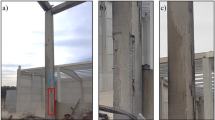Abstract
In this study, a combined fiber technique is applied to large high strength concrete specimens with different boundary conditions, and its effects on the fundamental properties of concrete and the spalling protection of concrete are investigated. Experimental test results showed that the application of the combined fiber technique could achieve the least reduction of slump flow, which, in turn, solved the problem of conventional fiber technique for the same level of spalling protection of concrete. Fiber content used for the combined fiber technique was 50 % less than the normal content used for the conventional fiber technique. In addition, this study proved that the new combined fiber technique is applicable to large specimens, but the level of its effectiveness is different. It was demonstrated that this different effectiveness of the combined fiber technique applied to columns, slab and beam is due to their size and boundary conditions.










Similar content being viewed by others
References
Heo YS, Sanjayan JG, Han CG, Han MC (2010) Synergistic effect of combined fibers for spalling protection of concrete in fire. Cem Concr Res 40:1547–1554
Khoury GA (2008) Concrete spalling assessment methodologies and polypropylene fibre toxicity analysis in tunnel fires. Struct Concr 9:11–18
Han CG (2009) Fire resistant performance of high strength concrete. In: 1st international workshop on improvement of fire resistance on high strength concrete, Seoul, pp 35–74
Consolazio GR, McVay MC, Rish JW ΙΙΙ (1998) Measurement and prediction of pore pressures in saturated cement mortar subjected to radiant heating. ACI Mater J 95:525–536
Sanjayan JG, Stocks LJ (1993) Spalling of High-strength silica fume concrete in Fire. ACI Mater J 90:170–173
Kalifa P, Chene G, Galle C (2001) High-temperature behaviour of HPC with polypropylene fibers from spalling to microstructure. Cem Concr Res 31:1487–1499
Msaad Y, Bonnet G (2006) Analysis of heated concrete spalling due to restrained thermal dilation: application to the Chunnel fire. J Eng Mech 132:1124–1132
Mindequia JC, Pimienta P, Noumowé A, Kanema M (2010) Temperature, pore pressure and mass variation of concrete subjected to high temperature—experimental and numerical discussion on spalling risk. Cem Concr Res 40:477–487
Gawin D, Pesavento F, Schrefler BA (2006) Towards prediction of the thermal spalling risk through a multi-phase porous media model of concrete. Comput Methods Appl Mech Eng 195:5707–5729
Diederichs V, Spitzner J, Sandvik M, Kepp B, Gillen M (1993) The behaviour of high-strength lightweight aggregate concrete at elevated temperature. In: Symposium on utilization of high strength concrete, Norweigian Concrete Association Lillehammer, Norway pp 1046–1053
Breitenbucker R (1996) High strength concrete C105 with increased fire resistance due to polypropylene fibres. In: Proceedings 4th international symposium on utilization of high-strength/high-performance concrete, Paris, pp 571–578
Khoury GA (2008) Polypropylene fibres in heated concrete_Part 2: pressure relief mechanisms and modelling criteria. Mag Concr Res 60:125–136
Heo YS, Sanjayan JG, Han CG, Han MC (2011) Critical parameters of nylon and other fibres for spalling protection of high strength concrete in fire. Mater Struct 44:599–610
Heo YS, Sanjayan JG, Han CG, Han MC (2012) Limited effect of diameter of fibres on spalling protection of concrete in fire. Mater Struct 45:325–335
Heo YS, Sanjayan JG, Han CG, Han MC (2012) Relationship between inter-aggregate spacing and the optimum fiber length for spalling protection of concrete in fire. Cem Concr Res 42:549–557
Guerrieri M, Sanjayan J, Collins F (2008) Effect of slag on the performance of concretes in hydrocarbon fire. ACI SP225-02: Designing Concrete Structure for Fire Safety, ACI-TMS Committee 216: Fire Resistance and Fire Protection of Structures 255:23–46
Standards Australia (2001) AS 3600-2009 concrete structures. Sydeny
Standards Australia (2009) AS 3600-2009 concrete structures. Sydeny
Building code of Australia (2013) BCA-2013 Australian Building Codes Board. Canberra
Kodur VKR, Phan L (2007) Critical factors governing the fire performance of high strength concrete systems. Fire Saf J 42:482–488
European Committee for Standardization (2004) Eurocode 2 Design of concrete structures_Part 1–2: general rules_structural fire design_Section 6 High strength concrete, Brussels
International Standards (1999) ISO 834-1 fire-resistance test—elements of building construction. Part 1: General requirements, printed in Switzerland
Heo YS (2011) Identification of fibre parameters for spalling protection of concrete in fire. PhD thesis, Monash University, Melbourne, Australia
Phan LT, Carino NJ (2002) Effects of test conditions and mixture proportions on behavior of high-strength concrete exposed to high temperature. ACI Mater J 99:54–66
Poon CS, Azhar S, Anson M, Wong YL (2001) Comparison of the strength and durability performance of normal- and high-strength pozzolanic concrete at elevated temperatures. Cem Concr Res 31:1291–1300
Han CG, Yang SH, Han MC, Pei CC (2008) Spalling prevention of high strength concrete with 60–100 MPa of the compressive strength corresponding to addition of polypropylene fibers. Archit Inst Korea 24:91–98
Heo YS (2006) Influential factors on fire resistance performance of ultra high strength concrete and mechanism models of spalling phenomenon. Master thesis, Cheongju University
Papworth F (2000) Affect of synthetic fibres and silica fume on explosive spalling of high performance concrete exposed to fire. South East Asia Construction, Trade Link Media Singapore, pp 1–6
Ali AZM, Sanjayan JG, Guerrieri M (2011) Spalling of full-scale high strength concrete wall panels with difference aggregate sizes. Int J Integr Eng 3:1–4
Acknowledgments
This research was supported by a grant (391) from Infrastructure and transportation technology promotion research Program funded by Ministry of Land, Infrastructure and Transport of Korean government.
Author information
Authors and Affiliations
Corresponding author
Rights and permissions
About this article
Cite this article
Heo, YS., Han, CG. & Kim, KM. Combined fiber technique for spalling protection of concrete column, slab and beam in fire. Mater Struct 48, 3377–3390 (2015). https://doi.org/10.1617/s11527-014-0406-4
Received:
Accepted:
Published:
Issue Date:
DOI: https://doi.org/10.1617/s11527-014-0406-4




